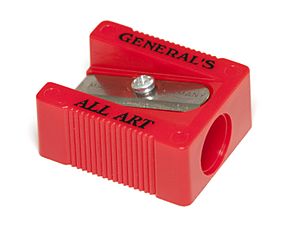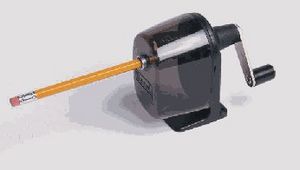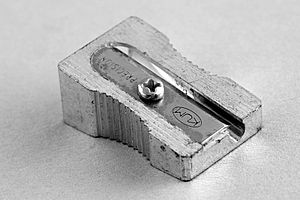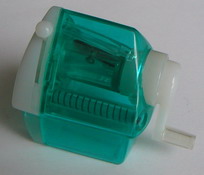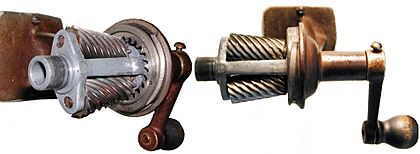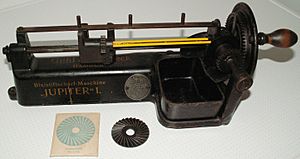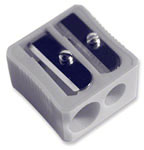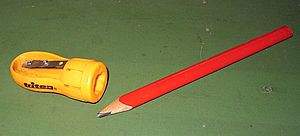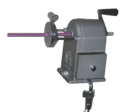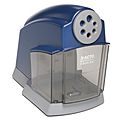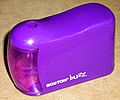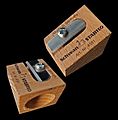Pencil sharpener facts for kids
A pencil sharpener is a handy tool that makes your pencil sharp again. It works by shaving off the dull part of the pencil's tip. You can find sharpeners that you use by hand or ones that run on electricity. Many sharpeners have a small container to catch the shavings, which you can easily empty into the trash. In Ireland, people sometimes call them a "parer" or "topper."
Contents
How Manual Sharpeners Work
Small Handheld Sharpeners
Small handheld sharpeners are often called "prism" sharpeners. They are usually the smallest and cheapest sharpeners you can buy. They are typically tiny blocks, about 2.5 cm long.
This type of sharpener has a hole where you put your pencil. Inside, a sharp blade is set up to shave the wood and graphite as you twist the pencil. The shavings come out through a slot next to the blade.
It's important that the hole fits your pencil snugly so the pencil doesn't wobble. If it wobbles, the tip might break. These sharpeners also have a slightly larger opening at the end of the cone. This helps if the pencil lead breaks off, making it easier to remove the broken piece. Some small sharpeners come with a cover to collect the shavings, which keeps things tidy.
A few prism sharpeners are hand-cranked. Instead of you turning the pencil, the sharpener's blade turns around the pencil. You need to be careful not to push too hard, or the pencil tip might break.
Pencils can have different sizes in different countries. If a sharpener's hole is too small, your pencil won't fit. If it's too big, the tip might keep breaking. Some sharpeners are made for right-handed people (you turn the pencil clockwise), and others for left-handed people (you turn it counter-clockwise).
Straight Blade Sharpeners
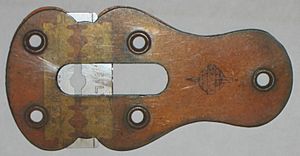
Unlike prism sharpeners, straight blade sharpeners don't spin around the pencil. They are more like a special knife with a guide to make them safer and easier to use. Some models use blades that you can replace, similar to razor blades. Others have blades that are permanently attached.
Straight blade sharpeners might need a bit more skill to use. But they let you sharpen your pencil tip into any shape or angle you want. Prism sharpeners, on the other hand, always sharpen to the same angle and a round tip.
In the past, some straight blade sharpeners were even crank-operated. They used special parts to change the crank's spinning motion into a straight cutting motion.
Desk or Wall Sharpeners (Planetary)
These sharpeners are often called planetary sharpeners because they use special gears, like planets orbiting a sun. They are larger and can be placed on a desk or mounted on a wall. You power them by turning a hand crank.
To use one, you hold the pencil in one hand and turn the crank with the other. This makes a set of spiral-shaped cutters spin. These cutters are angled to each other and quickly sharpen the pencil. They often give a smoother, more precise finish than sharpeners with just one blade. Most planetary sharpeners have two or more of these spinning cutters.
Many of these sharpeners have a large opening with a spinning disk in front. This disk has holes of different sizes, so you can sharpen pencils of many different thicknesses. Some advanced models have a spring that pushes the pencil into the sharpener automatically. Some even let you choose how sharp you want the pencil to be, because you don't always need a super-sharp point.
Other Sharpening Methods
Some older sharpeners, like the German Jupiter 1 from 1897, used spinning disks with cutting edges. These were usually very fancy, large, and expensive. Other methods simply used rough materials like sandpaper to sharpen the pencil. Sometimes, sandpaper was used only for the graphite lead, while the wood was cut in a different way.
Electric Pencil Sharpeners
Electric pencil sharpeners first appeared around 1940. They work much like manual sharpeners, but an electric motor spins the cutters (either flat blades or cylindrical ones). Some electric sharpeners run on batteries, making them easy to carry around, while others plug into a wall outlet.
Some electric sharpeners are "auto-stop." This means they can tell when the pencil tip is sharp enough and stop sharpening automatically. With simpler electric sharpeners, you have to watch carefully, or the lead might get too long and break.
Specialized Sharpeners
You can find special sharpeners for things like wax crayons, which are often used in younger grades. Sharpeners with two holes – one for regular pencils and one for larger crayons – are quite common. Some crayon boxes even come with a simple sharpener that has a plastic blade, which works well for soft wax crayons.
Artists and drafters sometimes use special sharpeners that only shave the wood part of the pencil, leaving the graphite untouched. Then, they use a separate tool called a lead pointer to sharpen just the graphite lead. Lead pointers are also used with mechanical lead holders, which hold leads that can be refilled. Some sharpeners have a second hole that sharpens the untouched graphite to a very long, precise point.
Carpenters often use carpenter pencils, which have a flat shape so they don't roll away. These pencils were traditionally sharpened with tools like a plane or sandpaper. Now, there are special sharpeners for them. However, these sharpeners usually make the carpenter's pencil into a regular round point, which changes how they are typically used.
Mechanical pencils don't need sharpening because the graphite lead comes out as you use it. Some mechanical pencils even have a spinning gear that turns the lead slightly each time you lift it from the paper. This helps keep the point sharp and consistent. If you need a different line thickness, you just use a mechanical pencil with a different lead size.
Pencil Sharpener Gallery
Images for kids
-
A lead sharpener (or lead pointer) and a 2 mm pencil lead in a leadholder.
-
An ecologically made pencil sharpener crafted from wood.
See also
 In Spanish: Sacapuntas para niños
In Spanish: Sacapuntas para niños


